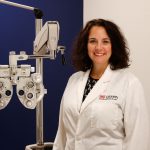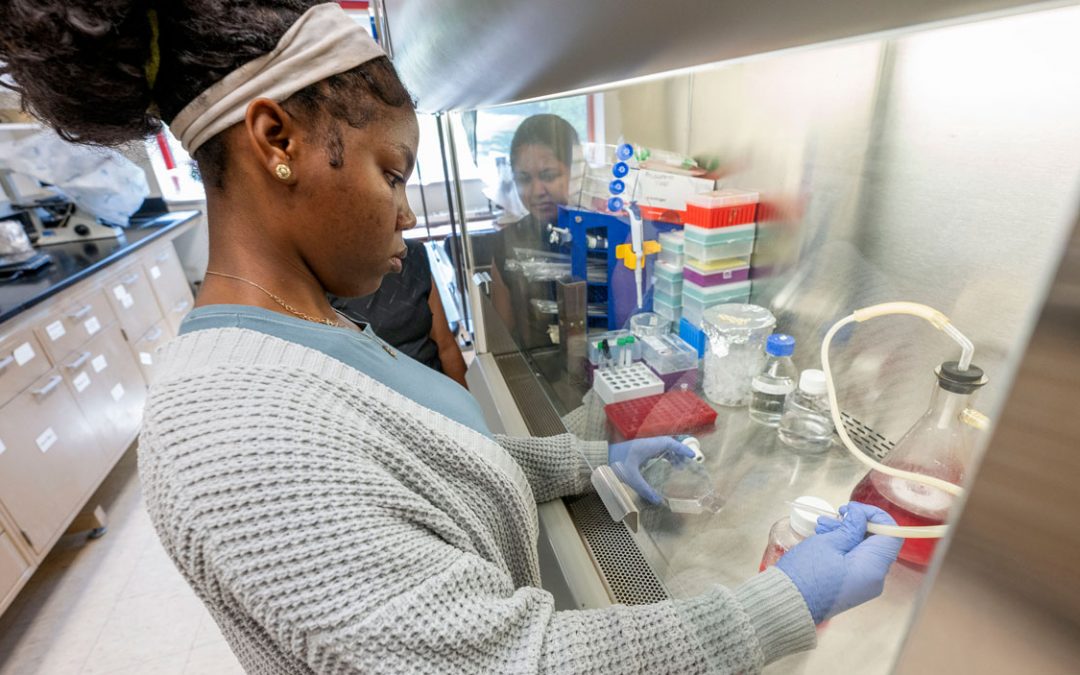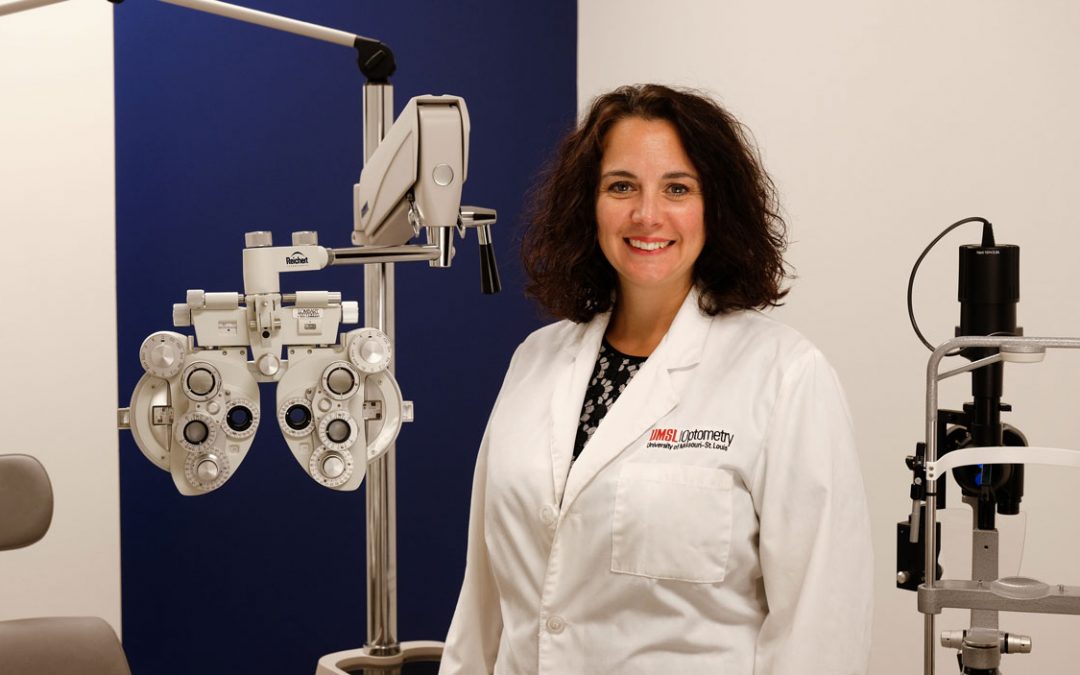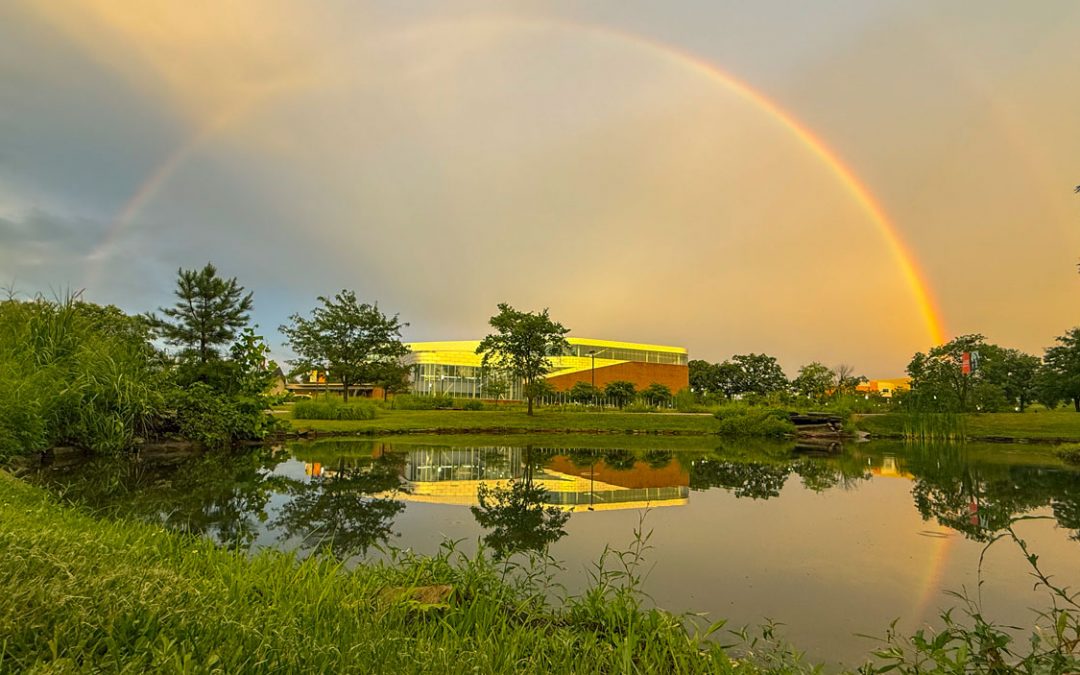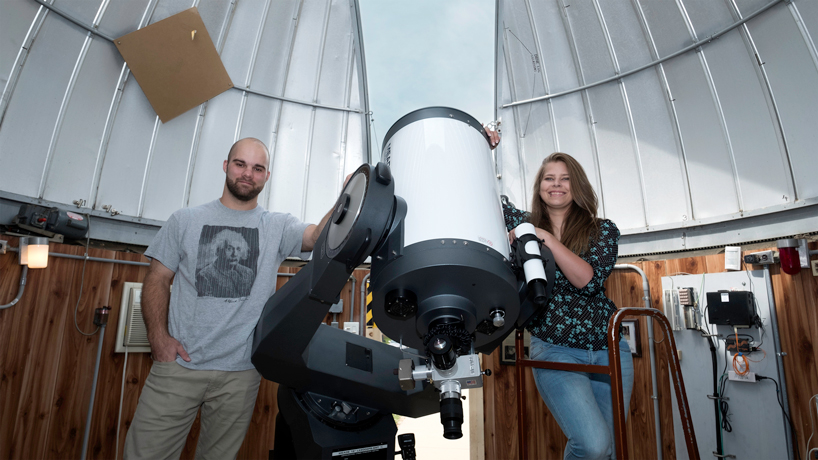
Justin Bryan (at left) and Lindsey Rodgers pose with the Meade LX-200 16-inch telescope they operate for shows at the Richard D. Schwartz Observatory on UMSL’s campus. Despite some quirks with the telescope, students and the public are privy to the beautiful and clear celestial bodies it magnifies. (Photos by August Jennewein)
It sounds sci-fi magical – star hopping across the universe.
“These four stars, you make a triangle and then go up at a 90-degree angle,” said Lindsey Rodgers, who leads the Richard D. Schwartz Observatory open houses at the University of Missouri–St. Louis. “After you’ve done it enough, you know where an object is every time. Arcturus. Vega. Betelgeuse.”
The recent astrophysics graduate listed off the giant stars she relies on to chart her path in the sky as she searches through the lens to locate more difficult objects – nebulae, star clusters and galaxies.
Rodgers has led the campus observatory shows, both public and private, for more than a year now. This summer, she hosts her final few open houses before passing off the student leadership role to senior astrophysics major Justin Bryan.
The Department of Physics and Astronomy has been making star hoppers of its astrophysics students for years, but only a select one or two with telescope experience and observational skill get to lead the shows.
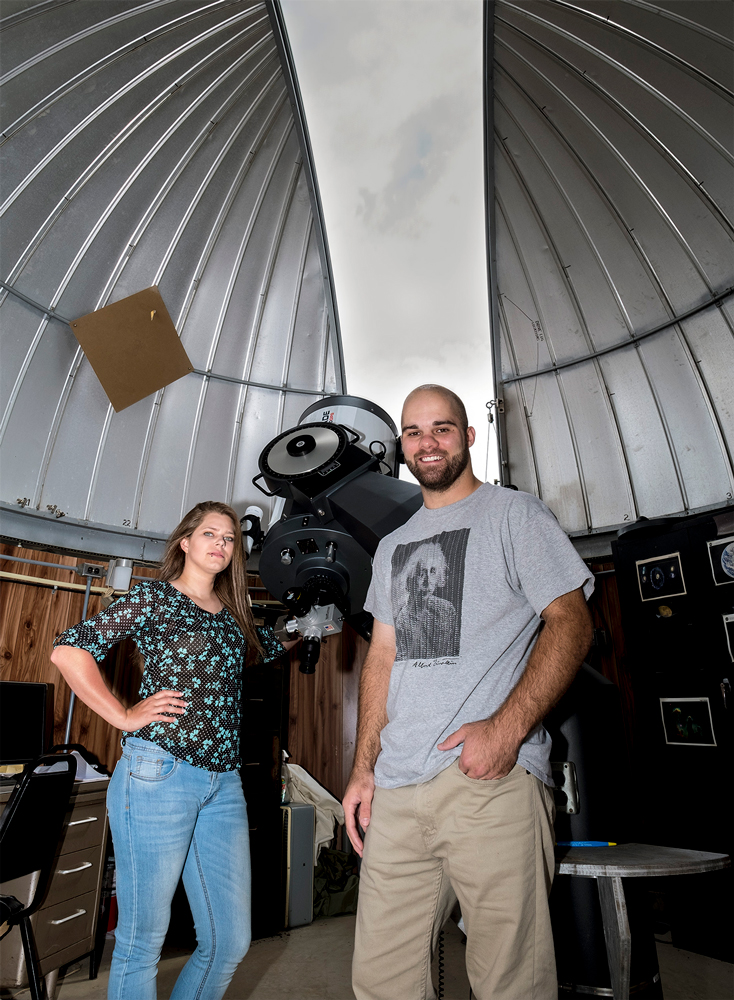
The Meade LX-200 16 inch telescope was gifted to the university in 2011 upon the death of Professor Emeritus Richard Schwartz, who originally established the observatory at UMSL in 1981. His 16-inch telescope was a huge update from the previous 14-inch that had occupied the observatory, which continues to be used for class observations, public open houses and private showings.
Skill is an important factor because, while star hopping may sound romantic, it’s also a navigational necessity working at the observatory. The Meade LX-200 16-inch telescope still captures magnificently clear sights of the sky. But accurately pointing it at objects takes a little more effort and luck since the mechanism to input coordinates and a few old motor gears to turn the telescope no longer function on their own.
That’s where learning to star hop and navigate the sky by objects becomes a tricky, but fun, challenge for students who have to manually position the telescope perfectly and lock it without flinching for fear of losing an object in sight. It definitely takes some practice and learning individual paths. No two people navigate the sky alike, according to Rodgers and Bryan.
“Once you find it, it’s such a great relief,” Bryan said, “but the process to get there is a lot harder than you think. Even in the winter – when there’s less humidity, making it easier to see through the atmosphere – I sometimes can’t find clusters because of light pollution and because I’m doing it by hand.”
Even so, Rodgers and Bryan talk about star hopping and learning to use the telescope as almost a rite of passage and a skill no UMSL astrophysics student can graduate without knowing. A required Observational Astronomy class that uses the observatory makes sure of that.
Many people are often surprised to hear UMSL has an observatory.
Tucked away by the softball field off of Florissant Road on North Campus is the white dome that houses two telescopes (the previously mentioned 16-inch and a smaller 8-inch telescope).
The observatory was first erected on UMSL’s campus in 1981 by Professor Emeritus Richard Schwartz. When he passed in 2011, he left his 16-inch telescope to the university, which was an upgrade from the previous 14-inch.
The observatory’s location on a metropolitan campus certainly comes with light pollution frustrations, but it also creates opportunities that far outweigh the negatives. Students who might have simply learned about astronomy and telescope operation in a classroom setting now get hands-on experience.
Another advantage – greater public outreach, which Rodgers and Bryan agree absolutely makes running the observatory.
“Whenever you tell them what they’re looking at, and their faces are just in complete awe, there’s no way…no way to describe it. It’s a joyful event. I have a smile on my face the entire time,” Bryan said. “It’s just a great feeling knowing you helped somebody look at the universe, see a part of the universe in a way that they’ve maybe never looked at before.”

Lindsey Rodgers and Justin Bryan pose with Rodger’s home telescope outside The Richard D. Schwartz Observatory. The observatory is located off Florissant Road by the softball field on UMSL’s North Campus.
For Rodgers the outreach goes a step further.
“I want to be able to encourage students or kids to be interested in STEM and astronomy,” she said. “I’m always excited when I look in the telescope, so I hope that when other people do that, and I can explain what they’re looking at and answer questions, that I can kind of help that along.”
Sponsored in part by the NASA/Missouri Space Grant Consortium, outreach and exposure to space science is a main goal of the observatory operation, headed by Professor of Astronomy Bruce Wilking. Public open houses are offered once a month, but school groups and other organizations can also sign up for private showings. One show lasts about an hour and you can expect to see five to six objects.
The next public open house is July 29. Expect to see Jupiter, Saturn, M13 Globular Cluster, Albireo and the Ring Nebula. And, of course, you’ll meet Rodgers and Bryan.
Rodgers plans to one day become a professor. Her first interest in space came after having children. She was a young teenage mom and would watch PBS and the Discovery Channel, dreaming of studying space as she took care of her kids. After earning her GED and now her undergraduate degree, the Pierre Laclede Honors College graduate and Eugene J. Meehan Scholarship recipient will continue toward her goal and study stellar formation in the astrophysics graduate program at Washington University in St. Louis this fall.
Bryan, like Rodgers, plans to become an educator one day. The Northwest High School graduate found space at the age of 16 when he started asking big questions like: “What is our universe?” “What is our solar system?” “What contains the Milky Way Galaxy?” After taking general education courses at St. Louis Community College–Meramec, Bryan transferred to UMSL with a Transfer Merit Scholarship and a Missouri Access Award that helps pay for his education. He intends to graduate May 2019.
Looking for more space fun at UMSL? Try the Astronomy Outreach Program partially sponsored by the NASA/Missouri Space Grant Consortium. It offers a space-packed day with classroom demonstrations that include making your own comet and a show in UMSL’s Planetarium.





